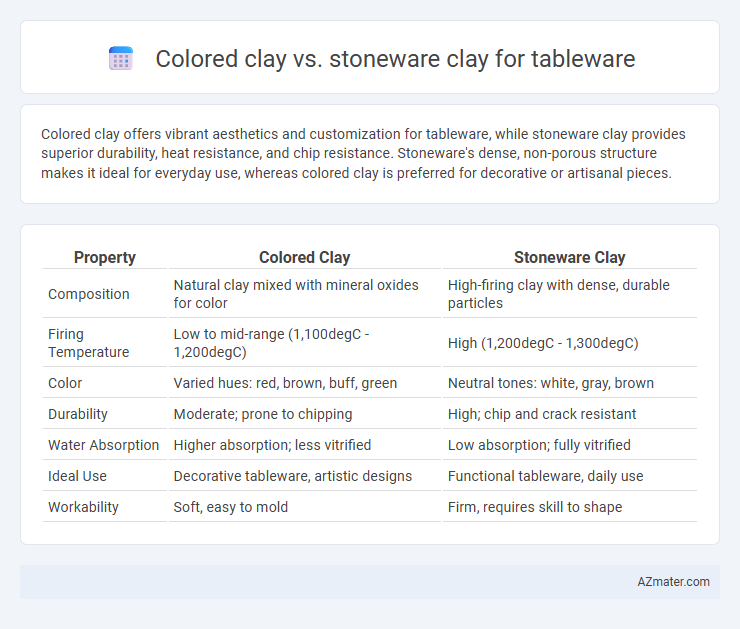Colored clay offers vibrant aesthetics and customization for tableware, while stoneware clay provides superior durability, heat resistance, and chip resistance. Stoneware's dense, non-porous structure makes it ideal for everyday use, whereas colored clay is preferred for decorative or artisanal pieces.
Table of Comparison
| Property | Colored Clay | Stoneware Clay |
|---|---|---|
| Composition | Natural clay mixed with mineral oxides for color | High-firing clay with dense, durable particles |
| Firing Temperature | Low to mid-range (1,100degC - 1,200degC) | High (1,200degC - 1,300degC) |
| Color | Varied hues: red, brown, buff, green | Neutral tones: white, gray, brown |
| Durability | Moderate; prone to chipping | High; chip and crack resistant |
| Water Absorption | Higher absorption; less vitrified | Low absorption; fully vitrified |
| Ideal Use | Decorative tableware, artistic designs | Functional tableware, daily use |
| Workability | Soft, easy to mold | Firm, requires skill to shape |
Introduction to Colored Clay and Stoneware Clay
Colored clay offers a wide range of vibrant hues achieved by adding natural or synthetic pigments during processing, making it ideal for decorative tableware with unique visual appeal. Stoneware clay, known for its durability and high firing temperature (typically between 1,200degC and 1,300degC), produces dense, non-porous tableware that withstands everyday use and thermal shock. Both clays differ in texture, firing behavior, and color retention, influencing the selection of materials based on aesthetic preferences and functional requirements for tableware production.
Material Composition and Origins
Colored clay for tableware often contains natural pigments and iron oxides that provide rich, vibrant hues, with origins rooted in specific mineral-rich regions like Japan and Italy. Stoneware clay is typically composed of a blend of kaolin, ball clay, and feldspar, known for its durability and high firing temperature, originating primarily from the United States and Europe. The material composition affects the final product's porosity, strength, and aesthetic qualities, with colored clays offering unique decorative finishes, while stoneware provides robust, functional ware.
Differences in Color and Texture
Colored clay offers a broad spectrum of hues embedded throughout the material, providing vibrant, consistent coloration without the need for surface glazes, whereas stoneware clay typically features natural earthy tones such as gray, brown, or buff, which are often enhanced with glazes. In terms of texture, colored clay tends to have a smoother, denser feel, making it ideal for finely detailed tableware, while stoneware clay exhibits a more coarse and grainy texture that contributes to its rustic and durable character. These differences influence the aesthetic choices and tactile experience for users seeking either bold visual appeal or traditional, robust durability in tableware.
Suitability for Tableware Applications
Colored clay offers vibrant hues ideal for decorative tableware but may require sealing to prevent staining and durability issues, making it better suited for casual or display pieces. Stoneware clay boasts high durability, chip resistance, and excellent suitability for everyday functional tableware due to its vitrification at high temperatures, ensuring food safety and longevity. When prioritizing practicality and long-term use, stoneware clay consistently outperforms colored clays in tableware applications.
Durability and Strength Comparison
Stoneware clay offers superior durability and strength compared to colored clay, making it ideal for tableware subjected to frequent use and thermal changes. Its high firing temperature creates a dense, vitrified body resistant to chipping, cracking, and moisture absorption. Colored clays, often lower-fired and more porous, are less resilient but provide aesthetic versatility for decorative tableware applications.
Firing Temperatures and Processes
Colored clay for tableware typically requires lower firing temperatures, often between 1,820degF to 2,192degF (995degC to 1,200degC), making it suitable for oxidation firing processes that preserve vibrant hues. Stoneware clay, on the other hand, fires at higher temperatures ranging from 2,192degF to 2,372degF (1,200degC to 1,300degC), achieving vitrification that enhances durability and water resistance. The firing process for stoneware often involves reduction or oxidation firings in gas kilns, whereas colored clays are commonly fired in electric kilns to maintain color integrity.
Glazing Compatibilities
Colored clay, often rich in iron or other metal oxides, can influence glaze color and texture, creating unique visual effects but sometimes reacting unpredictably during firing. Stoneware clay, known for its durability and high firing temperature, typically provides a smooth, vitrified surface that is highly compatible with a broad range of glazes, ensuring consistent finish and strength. Understanding their chemical composition and firing temperature is crucial for selecting glazes that enhance both aesthetic appeal and functional durability in tableware.
Aesthetic and Design Possibilities
Colored clay offers vibrant, intrinsic hues that enhance tableware with natural, variegated patterns, allowing for seamless blending of color and texture without the need for glazes. Stoneware clay provides a durable, versatile base, often finished with diverse glazes to achieve sophisticated surface effects, ranging from matte to glossy, and a wide palette of colors and textures. Combining colored clay's inherent pigments with stoneware's structural strength expands aesthetic and design possibilities, enabling unique handcrafted pieces that balance functionality with artistic expression.
Safety, Toxicity, and Food Compatibility
Colored clay often contains added pigments that can sometimes introduce toxic elements, making it crucial to verify non-toxic, food-safe certification, especially for tableware. Stoneware clay, typically fired at high temperatures (around 1200-1300degC), tends to be more vitrified, creating a dense, non-porous surface that is highly food-safe and resistant to leaching harmful substances. Both clays require proper glazing with food-safe materials to ensure safety, but stoneware clay inherently offers better durability and lower toxicity risk for everyday tableware use.
Cost and Accessibility for Artists
Colored clay often presents a higher upfront cost due to the inclusion of pigments and specialized blending, making it less accessible for emerging artists compared to stoneware clay. Stoneware clay is widely available, generally more affordable, and offers versatility, making it a popular choice for tableware production. Bulk purchasing options and local suppliers further reduce expenses and enhance accessibility for artists working with stoneware.

Infographic: Colored clay vs Stoneware clay for Tableware
 azmater.com
azmater.com